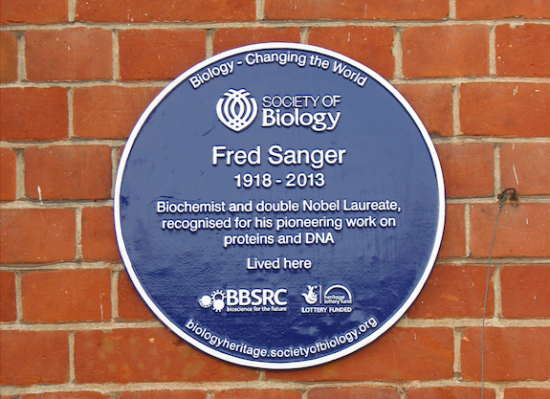News archive
Plaque celebrating Fred Sanger unveiled in Cambridge
- Details
- 08 March 2015
On Saturday 7th March a plaque celebrating Fred Sanger, the father of DNA sequencing, was unveiled at his former home in Cambridge.
Sanger lived at 252 Hills Road for over 40 years, in which time he won the Nobel Prize for Chemistry twice: in 1958, for his work on the structure of proteins, and in 1980 for his work on DNA sequencing. He remains one of only two people to have won the prize twice in the same category.
The Society of Biology installed the plaque as part of a new series of ten blue plaques around the UK celebrating the eminent but sometimes unsung heroes of biology.
At the unveiling ceremony Professor Julian Parkhill FSB, head of pathogen genomics at the Wellcome Trust Sanger Institute, gave a speech:
"The work that Fred Sanger did was basic science - curiosity driven research. He was among the first to show that biology is defined by specific information encoded in genomes. However, the elegant techniques he invented to read that code have led directly to the genomics revolution, with enormous and still-increasing benefits for human health, agriculture, industry and the environment. Most fundamentally, Fred Sanger allowed us to read our own instruction set, and see, as individuals and as a species, how we are made and where we came from."
Sanger (1918-2013) was the first person to determine the chemical structure of a protein, namely insulin. This led to the production of insulin in a laboratory, and hence the treatment of diabetes. Sanger and his group later produced the first whole genome sequence. His techniques have led to the field we now call genomics and to research into tailoring medicines to an individual based on their unique DNA sequence.
Fred’s son, Robin Sanger, also gave a speech:
"My father, research biochemist, national treasure and double Nobel Prize winner lived here between 1939 and 1981. As my father I can say he was my hero. He cared for and comforted me, played with me, as well as advising and mentoring me through life's problems. But he was not just a hero to me, he was also a hero to his colleagues and fellow scientists who could learn from him and to the wide world at large which was to benefit from his discoveries in the field of gene sequencing. Like all heroes, he needed his own fortress of solitude to retreat to. At 252 he could relax and enjoy his reading, gardening, woodwork and many other hobbies whilst being able to enjoy his family's company and to continue with his research projects.”
The new series of celebratory plaques also include those to: Steptoe, Edwards and Purdy, IVF pioneers, in Oldham; Richard Owen, who invented the word ‘dinosaur’ and founded the Natural History Museum, in Lancaster; and Dolly the sheep, and the team who created her, in Edinburgh.
The ten blue plaques are part of the national Biology: Changing the World project; which also includes a new app, website, public engagement programme and teaching resources. The free app, available in the apple and android app stores, uses your location to introduce you to the great biologists who lived and worked nearby and biological discoveries which were made in the area.
Dr Mark Downs FSB, chief executive of the Society of Biology said:
“We have a great heritage of scientific discovery and an exciting future, but the biologists who have contributed to our understanding of the world are not always given the appreciation they deserve. We are delighted to be giving these biologists the recognition awarded to other great historical figures through Biology: Changing the World. The project is also a celebration of biology and biologists today. The life sciences will be essential for solving the problems of the 21st Century such as food security and antibiotic resistance. By highlighting our great biology heritage we hope to inspire the next generation.”
The Biology: Changing the World project of the Society of Biology was developed in partnership with the Biotechnology and Biological Sciences Research Council (BBSRC) and received funding from the Heritage Lottery Fund.
Professor Jackie Hunter, chief executive of the BBSRC, said:
“I’m delighted that BBSRC has been involved with this scheme to raise the profile of unsung heroes of bioscience who have changed the world with their contributions. We hope that these plaques will spark curiosity and help inspire new generations to get involved in the biosciences, which will continue to change the world and help us meet the challenges of the future.”

